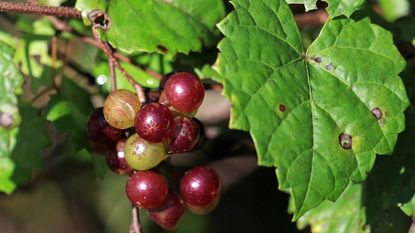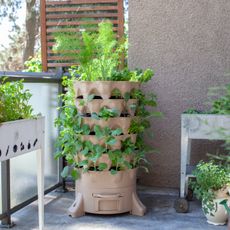Wild Muscadine Grapes: The Rich American History Of Muscadine Grapes


France can have its Cabernet and Petit Verdot, but here in the U.S.A. we have our own grapes, wild muscadine grapes. Muscadine grape history is rich in this region. Native to the Southeastern United States, wild muscadine grapes (Vitus rotundifolia) have been utilized for over 400 years, first by Native Americans and then by emigrating settlers. While they may not have the same pedigree as their French cousins, muscadine grapes have their own place in history.
History of Muscadine Grapes
Native Americans dried wild muscadine grapes long before European explorers discovered the continent. They used the grapes not only as a food source but also as a source of blue dye. More recently, muscadine grapes have made their way into pies and jellies and the ubiquitous Southern favorite muscadine wine. Enter the early English explorer Sir Walter Raleigh, who in 1584 marveled at the cornucopia of abundance, with muscadine vines growing on everything from the sand to the hills and on the plains and even up into the towering cedars. Wild muscadine grapes are also known as Southern fox grapes or, my favorite, scuppernongs - just because it's fun to say. My entertainment aside, the grape was named 'Scuppernong' after the area in which it was discovered by Isaac Alexander of North Carolina, who originally dubbed this bronze variety 'Big White Grape.' I guess he needed a catchier name.
Additional Information about Wild Muscadine Grapes
As time passed, the name 'Scuppernong' became synonymous with all muscadine grapes. This is actually a fallacy in that scuppernong is only one of a number of cultivars. Dark fruited muscadines are more reliably referred to as Bullis and its variations such as Bullace, Bullet grape, or Bull Grape. While 'Scuppernong' bronze and 'Thomas' black are the most recognizable of the cultivars, 100 years of breeding has yielded new and improved varieties such as Carlos, Doreen, Magnolia, Nesbitt, Noble and Regale, all of which are self-fruitful. Other cultivars such as Fry, Higgins, the aforementioned Scuppernong, and Jumbo require a partner for pollination. Muscadine wine may become more popular outside of the American South. More than 400 years after English explorers lauded the prolific vines, muscadine grapes are in the news as one of the newest health foods. Scientists with the USDA's Agricultural Research Service have noted that the muscadine grape contains large quantities of resveratrol. Resveratrol has been noted in both French red and white wines and is touted as being able to lower cholesterol and the incidence of coronary heart disease. Cheers to that!
Gardening tips, videos, info and more delivered right to your inbox!
Sign up for the Gardening Know How newsletter today and receive a free download of our most popular eBook "How to Grow Delicious Tomatoes."

Amy Grant has been gardening for 30 years and writing for 15. A professional chef and caterer, Amy's area of expertise is culinary gardening.
-
 Clever Vertical Vegetable Garden Ideas For Small Spaces – 7 Ways To Save Space
Clever Vertical Vegetable Garden Ideas For Small Spaces – 7 Ways To Save SpaceShort on garden space? Learn some vegetable garden ideas for small spaces that are fun and easy.
By Mary Ellen Ellis
-
 26 Different Types Of Orchids – With Pictures & Information
26 Different Types Of Orchids – With Pictures & InformationDiscover stunning orchid types to grow in your home and garden – from easy beginner varieties to rare and exotic species that are the preserve of experts.
By Melanie Griffiths